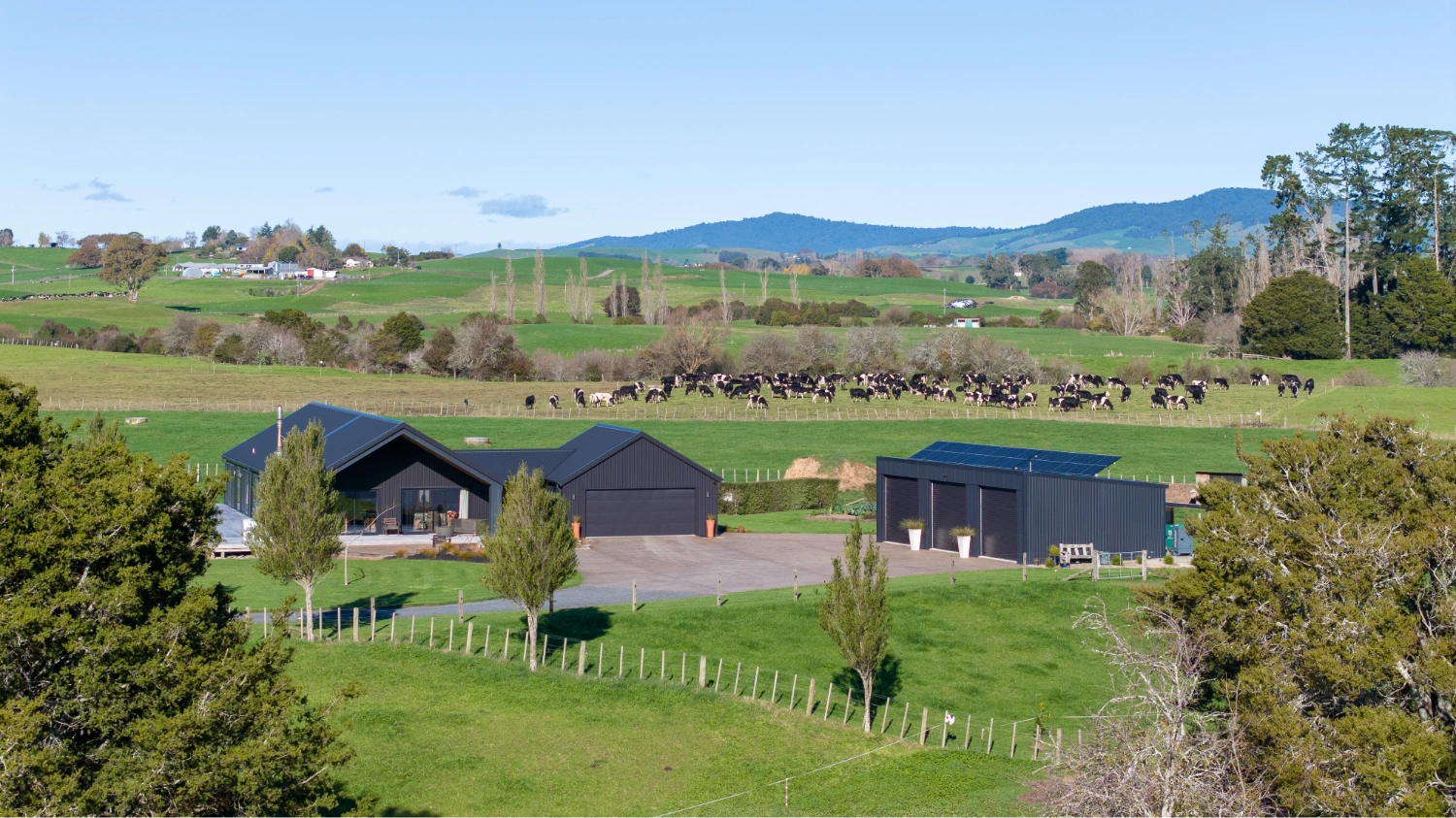What is an Off-Grid solar system?
An off-grid solar system is a fully self-sufficient energy system that operates without any connection to the national electricity grid. It generates, stores, and supplies electricity independently - using solar energy during the day and stored battery power at night. Given that independence requirement, proper system sizing and battery storage is critical for success.
A typical off-grid system includes:
- Solar panels – capture energy from the sun
- Battery storage – stores energy for use at night or in low-sunlight conditions
- Inverter – converts stored energy into standard AC power for household use
- Charge controller – manages how energy flows into the battery system, protecting against overcharging
- Backup generator (optional but often essential) – offers added reliability during long stretches of poor weather or periods of unusually high usage
In an off-grid setup, there’s no reliance on utility companies - everything you need to power your home or property is generated and managed on site.
How it differs from grid-tied or hybrid systems:
Unlike grid-connected solar setups, off-grid systems have no external backup from the national grid. A hybrid system still uses batteries but stays connected to the grid for added support. Off-grid systems are completely independent - and require careful design to ensure year-round reliability.

New Zealand's solar potential
New Zealand benefits from a lot of sunshine hours, with most regions receiving between 1,500 and 2,500 hours of sunshine annually. In the North Island, regions like Northland, Bay of Plenty, Tairawhiti and Bay of Plenty have the highest solar irradiance levels in the country. Even Southern regions get high sunshine hours, though winter performance is more challenging. Coastal areas can benefit from clearer skies and higher solar irradiance while mountainous regions may experience more cloud cover. Understanding your regional performance is fundamental to designing an effective off-grid system.
Why go Off-Grid?
Off-grid solar isn’t just for highly private eco-citizens or remote basic tramping huts. Across New Zealand, more people are turning to off-grid systems as a practical, long-term solution to rising energy costs (compounded by ‘necessary’ electricity infrastructure investments forecasted for the next decade), increasing resilience and extreme weather requirements and consumer knowledge empowering kiwi to confidently take on more energy agency.
In many parts of the country now- from the Far North to the West Coast - grid connection can be difficult and prohibitively expensive. Even where access exists, line charges and ongoing network fees are adding up quickly.
But going off-grid isn’t just about avoiding those costs. It’s about gaining:
- Energy independence - taking more control over how your power is generated, used and stored
- Resilience - staying powered during extreme weather events and unexpected outages
- Sustainability – reducing your reliance on fossil fuels and living with a lighter footprint
Is Off-Grid right for you?
Going off-grid offers freedom and self-reliance - but it’s not for everyone. It works best when your property, lifestyle, and energy needs align with what off-grid solar can realistically provide.
Here are five key questions to ask yourself:
1. Is my location well suited for off-grid?
What are local grid connection costs? How far am I from connection points? What is the solar irradiance performance here?
2. How much energy do we use - and when?
Understanding your daily and seasonal power needs is essential. Heating, pumping water, or charging an EV all place different demands on a system.
3. Are we ready for the investment?
Off-grid systems involve a higher upfront cost, not least because batteries are involved - but they’re designed to deliver long-term value with low ongoing costs.
4. How will we approach backup?
Do you have a generator on site and are you comfortable with the fact that you may need to run it from time to time in winter or poor weather periods?
5. Are you keen to live more energy-aware?
Living off-grid means paying closer attention to how and when you use power. That might include shifting high-usage tasks to daylight hours or planning around your battery storage levels.
For many people, this kind of conscious living is a benefit - not a burden. And with the right system design, there’s no need to compromise on comfort or performance.
Off-grid living simply means thinking a little differently about how you use energy - and having a system that’s built to support that.
How Off-Grid Solar works (step-by-step overview)
Your system needs to generate, store, and supply 100% of your electricity - all year round.
Here’s how the process works, step by step:
- Solar panels collect energy from the sun during the day, producing direct current (DC) electricity.
- That energy flows through a charge controller, which regulates how it’s sent to your batteries - protecting them from overcharging and managing flow efficiently.
- Battery storage holds the DC energy so it’s available at night or during cloudy weather.
- An inverter converts the stored DC power into alternating current (AC) electricity, which powers your lights, appliances, and devices.
- If your batteries run low, a backup generator may automatically kick in to keep everything running - especially during long periods of poor weather.

What this looks like in practice
In summer, your panels often generate more electricity than you use. That surplus charges your battery bank, giving you plenty of stored power for the evening and overnight.
In winter, or in areas with fewer average sun hours, your system may rely more on battery reserves - and occasionally, your generator. Since there’s no grid to fall back on, backup energy planning is a key part of any off-grid system.
The key is having a system that’s properly sized to your lifestyle. That means balancing solar generation, battery capacity, and backup options - all based on how much power you use and when you use it.
Watch how an off-grid solar system powers your home - A simple walkthrough of how solar generation, battery storage, and backup all work together to keep you powered, day and night.
Key components of an Off-Grid Solar system
Off-grid systems can vary widely in size and setup - but they all rely on the same core components. Each one plays a critical role in ensuring your system performs reliably, efficiently, and safely year-round.
Solar panels
Key things to consider:
- Panel efficiency - how much energy each panel can generate
- Durability - resistance to salt air, snow load, or extreme UV
- Placement and angle - optimised for seasonal sun paths, especially in winter
High-efficiency monocrystalline panels are the most common choice for off-grid systems due to their output and reliability.
Battery storage
Batteries are what set off-grid systems apart. They store the solar energy you generate during the day so it’s available at night or during periods of low sunlight.
Lithium batteries are now the go-to for off-grid systems in NZ. Compared to older lead-acid models, they offer:
- Higher usable capacity (up to 90% of total charge)
- Longer lifespan (10–15 years in most systems)
- Less maintenance and better performance in variable climates
System size and autonomy will determine how many days of battery storage are needed - typically 1.5 to 3 days is standard for NZ homes.
Inverter
Inverters can be:
- All-in-one hybrid units (integrated with batteries, charge controller and monitoring)
- Modular (standalone and scalable)
Backup generator
Even the best off-grid solar systems may need support during long stretches of cloud or high demand. A generator acts as your backup - automatically kicking in when battery levels get low. The right choice depends on your system size, usage patterns, and whether the generator is for backup only or plays a regular supporting role.
Monitoring systems
Modern off-grid systems often include smart monitoring tools that let you track:
- Battery levels
- Solar generation
- Power consumption
- Generator activity
These systems can be accessed remotely, helping you troubleshoot issues, optimise usage, and ensure everything runs smoothly - even if you’re not always on-site.

About ZEN Energy
ZEN Energy is a New Zealand-owned solar company specialising in off-grid system design, engineering, and installation. Since 2014, we’ve completed over 1,000 solar installations across the country - from remote homes to large-scale rural projects. With over 50 years of combined technical expertise, we build dependable off-grid systems tailored to New Zealand’s unique conditions. Every installation is backed by rigorous engineering review, world-leading components, and lifetime support.
Off-grid system design: getting it right
Off-grid systems don’t have the luxury of falling back on the grid when the weather turns or demand spikes. That’s why getting the design right from the start is so important - and why poor workmanship, DIY experimentation and guesswork can lead to expensive consequences later. A properly designed off-grid system needs expert calculations, considered engineering and thorough installation standards.
Why professional design matters:
- Under-sized setups can leave you short in winter or during extended cloudy periods
- Overbuilt systems may inflate your costs without delivering extra value
- Poorly balanced systems might need early upgrades or frustrate you with performance issues
The first step is to conduct a load analysis - a detailed look at how much electricity you use, when you use it, and what needs to stay running no matter what. This forms the foundation for sizing your solar array, battery bank, and generator support.
At ZEN Energy, we will start every project by understanding our clients' day-to-day energy needs - whether that includes running a bore pump, charging an EV, keeping a fridge and freezer cold 24/7, or staying online from a remote home office.
From there, we ensure the design will take into consideration:
- Orientation and tilt of panels for year-round generation
- Local solar conditions
- Desired battery autonomy - typically 2–3 days is a good baseline in NZ
- Available roof or ground space
- Future-proofing for system expansion or servicing
Off-Grid solar in New Zealand: regional considerations
From the Far North to Southland, New Zealand’s geography and weather patterns vary widely - as do the requirements for designing and installing a reliable off-grid solar system.
Key things that need local consideration:
- Sunlight and seasonal conditions: to ensure system design optimisation
- Accessibility and installation logistics: remote or hard-to-reach properties often add complexity and cost to installation and ongoing servicing
- Compliance and consenting requirements: despite not being connected to the grid, systems will need to meet NZ electrical and building codes and be signed off by a licensed electrician
- Ground mounted arrays: local council consenting rules will need to be adhered to regarding aspects like visibility, height, erosion considerations, glare risk, and more
Costs and Investment
Off-grid solar isn’t just about powering your home - it’s about taking long-term control of your energy future. While it comes with a higher upfront investment than most grid-tied systems, for many rural or remote properties in New Zealand, it’s the only viable option.
And over time, the benefits stack up: no monthly power bills, no rising line charges, and no surprise connection fees.
Every off-grid system ZEN Energy designs is custom-built to match the energy profile of the property - and the people who live there. The examples below offer a guide to typical pricing, based on real-world usage patterns.
Note: Prices include solar panels, inverter, battery storage, charge controller, mounting (roof or ground), cabling, installation, and professional system design and engineering. Generator costs are excluded but often recommended as part of a resilient setup.
Small system - from $38,700 (incl. GST)
Ideal for: Tiny homes, cabins, or solo dwellings
Appliances supported: Lighting, phone charging, small fridge
System profile:
- 14 solar panels
- 6.16 kW solar capacity
- 20 kWh battery storage
Mid-sized system - from $58,300 (incl. GST)
Ideal for: Small family homes or couples
Appliances supported: Standard fridge, washing machine, TV, moderate computer use
System profile:
- 20 solar panels
- 8.8 kW solar capacity
- 30 kWh battery storage
Large system - from $69,500 (incl. GST)
Ideal for: Full family homes with high energy use
Appliances supported: Multiple large appliances, HVAC, EV charging, lighting, devices
System profile:
- 28 solar panels
- 12.32 kW solar capacity
- 40 kWh battery storage
What influences cost?
The final price of your system depends on several key factors:
System capacity and usage
- Your daily and seasonal energy needs
- How many days of backup autonomy you require
- Whether you want to power essentials or everything
Battery and backup requirements
- Battery size and quality
- Generator integration and fuel type
- Desired resilience during winter or poor weather
Property and install complexity
- Roof vs ground-mounted array
- Site access, terrain, remoteness
- Weather conditions or install timing
Technology and features
- Monitoring and smart controls
- EV or appliance integration
- Future-proofing for upgrades
Customisation and components
- Preferred brands and warranties
- Modular vs fully tailored system design
- Load management and redundancy options
Over the lifespan of your system, a well-designed off-grid setup offers long-term energy certainty - with no ongoing power bills, no network charges, and no need to rely on infrastructure that may not exist where you live.
Maintenance and Reliability
A well-designed off-grid system should run quietly and efficiently in the background - giving you consistent, dependable power without constant attention. But like any energy system, a little regular maintenance goes a long way towards long-term performance.
Routine system care
Most systems require only basic, periodic checks:
- Panel inspection – Clear dust, debris, or any shading that may affect output
- Battery monitoring – Keep an eye on voltage, temperature, and charge/discharge cycles
- Inverter checks – Ensure it’s operating within normal ranges and showing no fault codes
- Generator servicing – Check oil levels, filters, and start-up function (even if rarely used)
Built-in system monitoring
Modern off-grid systems typically include remote monitoring tools that allow you (and your installer) to:
- Track battery health and solar production
- Monitor appliance loads
- Flag potential issues early
- Optimise performance remotely
These tools take the guesswork out of off-grid living - and make it easy to maintain your system with minimal manual checks.
Battery lifespan and care
Lithium batteries are the standard for most off-grid systems in New Zealand. With proper setup and use, you can typically expect:
- 10–15 years of reliable performance
- Minimal maintenance (compared to older lead-acid batteries)
- Good resilience to temperature shifts and daily cycling
Keeping batteries within their recommended charge range - and not routinely draining them to zero - will extend their useful life.
Year-round reliability
New Zealand’s weather can be unpredictable - and a few grey days in a row are always a possibility. That’s why most off-grid systems are built with redundancy in mind:
- 2–3 days of battery autonomy
- Smart usage planning during winter or low-sun periods
- Automatic generator backup if battery levels drop too low
This layered approach ensures your home stays powered - even during the toughest weather stretches.
What happens when it’s cloudy? Your battery bank steps in first. If levels drop too low, your generator provides backup power - automatically. You stay powered throughout, without needing to intervene.
Rural lifestyle property | Off-grid system overview
Location: Morrinsville, Waikato
System Type: Fronius + Selectronic off-grid solar system
Property Type: Primary residence, rural lifestyle block
Install Overview:
- 16 x LONGi 370W PERC Half Cut panels (black frame, tilt-mounted)
- 8 x Pylontech US3000 lithium batteries
- Fronius + Selectronic off-grid inverter system
- Generator installed for backup support

Why they chose off-grid solar
For this rural Waikato property owner, the decision was simple - getting connected to the grid would have cost over $75,000 just to bring lines down the driveway.
Instead, they chose to invest in a fully off-grid solar system designed to power their home independently. Four years on, the system is still going strong - delivering reliable power, low maintenance, and complete peace of mind.
“Power's everything we need. Have a generator if we get a run of bad weather but don't need it very often at all.”
System performance and everyday experience
The system supports all essential household loads and provides year-round autonomy, with minimal generator use even during stretches of poor weather. With smart system design and quality components, this rural home runs comfortably and confidently off the grid.
Off-grid solar: practical, proven, and built for NZ
For many parts of New Zealand, off-grid solar isn’t a lifestyle choice - it’s simply the most practical way to get reliable, long-term power. If you're living remotely, building on rural land, or too far from the nearest lines company, going off-grid means you’re no longer dependent on infrastructure that may not reach you.
Across the country, off-grid systems are delivering dependable electricity without power bills, without lines charges, and without compromise.
But getting it right starts with good planning. Understanding your energy needs, sizing your system for the seasons, and choosing quality components built for New Zealand conditions all play a critical role in long-term performance.
Thinking about going off-grid? Talk to the specialist off-grid team at ZEN Energy for expert advice, tailored system design, and a setup built to work - wherever you are.




